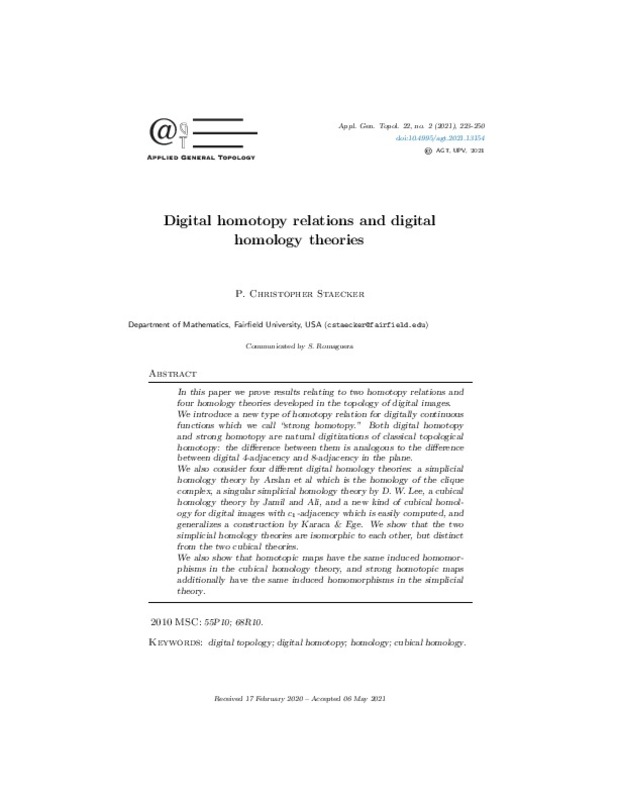JavaScript is disabled for your browser. Some features of this site may not work without it.
Buscar en RiuNet
Listar
Mi cuenta
Estadísticas
Ayuda RiuNet
Admin. UPV
Digital homotopy relations and digital homology theories
Mostrar el registro sencillo del ítem
Ficheros en el ítem
| dc.contributor.author | Staecker, P. Christopher
|
es_ES |
| dc.date.accessioned | 2021-10-06T06:23:23Z | |
| dc.date.available | 2021-10-06T06:23:23Z | |
| dc.date.issued | 2021-10-01 | |
| dc.identifier.issn | 1576-9402 | |
| dc.identifier.uri | http://hdl.handle.net/10251/173894 | |
| dc.description.abstract | [EN] In this paper we prove results relating to two homotopy relations and four homology theories developed in the topology of digital images.We introduce a new type of homotopy relation for digitally continuous functions which we call ``strong homotopy.'' Both digital homotopy and strong homotopy are natural digitizations of classical topological homotopy: the difference between them is analogous to the difference between digital 4-adjacency and 8-adjacency in the plane.We also consider four different digital homology theories: a simplicial homology theory by Arslan et al which is the homology of the clique complex, a singular simplicial homology theory by D. W. Lee, a cubical homology theory by Jamil and Ali, and a new kind of cubical homology for digital images with $c_1$-adjacency which is easily computed, and generalizes a construction by Karaca \& Ege. We show that the two simplicial homology theories are isomorphic to each other, but distinct from the two cubical theories.We also show that homotopic maps have the same induced homomorphisms in the cubical homology theory, and strong homotopic maps additionally have the same induced homomorphisms in the simplicial theory. | es_ES |
| dc.language | Inglés | es_ES |
| dc.publisher | Universitat Politècnica de València | es_ES |
| dc.relation.ispartof | Applied General Topology | es_ES |
| dc.rights | Reconocimiento - No comercial - Sin obra derivada (by-nc-nd) | es_ES |
| dc.subject | Digital topology | es_ES |
| dc.subject | Digital homotopy | es_ES |
| dc.subject | Homology | es_ES |
| dc.subject | Cubical homology | es_ES |
| dc.title | Digital homotopy relations and digital homology theories | es_ES |
| dc.type | Artículo | es_ES |
| dc.identifier.doi | 10.4995/agt.2021.13154 | |
| dc.rights.accessRights | Abierto | es_ES |
| dc.description.bibliographicCitation | Staecker, PC. (2021). Digital homotopy relations and digital homology theories. Applied General Topology. 22(2):223-250. https://doi.org/10.4995/agt.2021.13154 | es_ES |
| dc.description.accrualMethod | OJS | es_ES |
| dc.relation.publisherversion | https://doi.org/10.4995/agt.2021.13154 | es_ES |
| dc.description.upvformatpinicio | 223 | es_ES |
| dc.description.upvformatpfin | 250 | es_ES |
| dc.type.version | info:eu-repo/semantics/publishedVersion | es_ES |
| dc.description.volume | 22 | es_ES |
| dc.description.issue | 2 | es_ES |
| dc.identifier.eissn | 1989-4147 | |
| dc.relation.pasarela | OJS\13154 | es_ES |
| dc.description.references | H. Arslan, I. Karaca and A. Öztel, Homology groups of n-dimensional digital images, in: Turkish National Mathematics Symposium XXI (2008), 1-13. | es_ES |
| dc.description.references | L. Boxer, A classical construction for the digital fundamental group, J. Math. Imaging Vision 10, no. 1 (1999), 51-62. https://doi.org/10.1023/A:1008370600456 | es_ES |
| dc.description.references | L. Boxer, Generalized normal product adjacency in digital topology, Appl. Gen. Topol. 18, no. 2 (2017), 401-427. https://doi.org/10.4995/agt.2017.7798 | es_ES |
| dc.description.references | L. Boxer, I. Karaca and A. Öztel, Topological invariants in digital images, J. Math. Sci. Adv. Appl. 11, no. 2 (2011), 109-140. | es_ES |
| dc.description.references | L. Boxer and P. C. Staecker, Remarks on fixed point assertions in digital topology, Appl. Gen. Topol. 20, no. 1 (2019), 135-153. https://doi.org/10.4995/agt.2019.10474 | es_ES |
| dc.description.references | O. Ege and I. Karaca, Fundamental properties of digital simplicial homology groups, American Journal of Computer Technology and Application 1 (2013), 25-41. | es_ES |
| dc.description.references | S.-E. Han, Non-product property of the digital fundamental group, Inform. Sci. 171, no. 1-3 (2005), 73-91. https://doi.org/10.1016/j.ins.2004.03.018 | es_ES |
| dc.description.references | A. Hatcher, Algebraic topology, Cambridge University Press, Cambridge, 2002. | es_ES |
| dc.description.references | S. S. Jamil and D. Ali, Digital Hurewicz theorem and digital homology theory, arxiv eprint 1902.02274v3. | es_ES |
| dc.description.references | T. Kaczynski, K. Mischaikow and M. Mrozek, Computing homology. Algebraic topological methods in computer science (Stanford, CA, 2001), Homology Homotopy Appl. 5, no. 2 (2003), 233-256. https://doi.org/10.4310/HHA.2003.v5.n2.a8 | es_ES |
| dc.description.references | I. Karaca and O. Ege, Cubical homology in digital images, International Journal of Information and Computer Science, 1 (2012), 178-187. | es_ES |
| dc.description.references | D. W. Lee, Digital singular homology groups of digital images, Far East Journal of Mathematics 88 (2014), 39-63. | es_ES |
| dc.description.references | G. Lupton, J. Oprea and N. Scoville, A fundamental group for digital images, preprint. | es_ES |
| dc.description.references | W. S. Massey, A Basic Course in Algebraic Topology,Graduate Texts in Mathematics, 127. Springer-Verlag, New York, 1991. https://doi.org/10.1007/978-1-4939-9063-4 | es_ES |
| dc.description.references | A. Rosenfeld, 'Continuous' functions on digital pictures, Pattern Recognition Letters 4 (1986), 177-184. https://doi.org/10.1016/0167-8655(86)90017-6 | es_ES |








